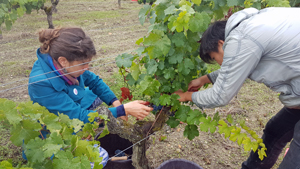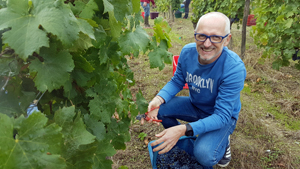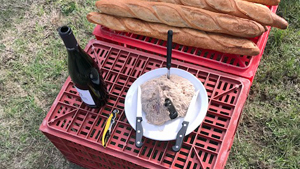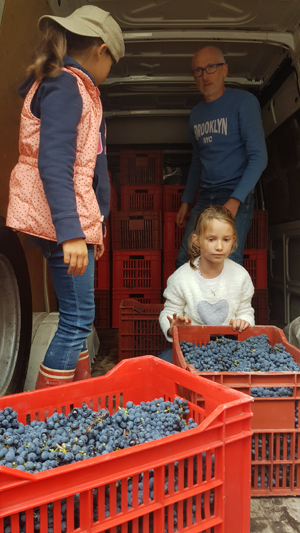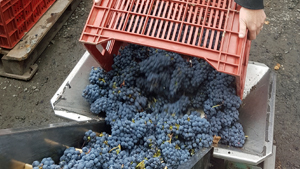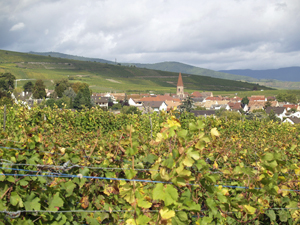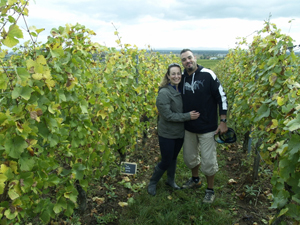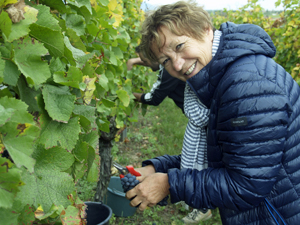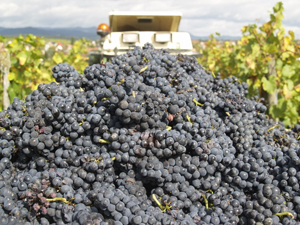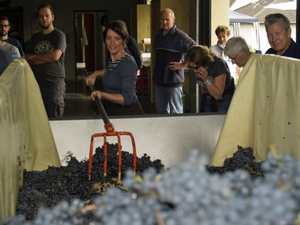Domaine Stentz-Buecher welcomed us to Alsace last weekend to get involved in picking the grapes and learn about the work at the winery during harvest time to transform the grape juice into wine. We were there with the Gourmet Odyssey Wine Experience clients who have each adopted a micro-plot of organic vines at the winery.
After the introductions, we crossed the picturesque village of Wettolsheim to visit the Rosenberg vineyard, home to our adopted vines. A small slate had been put in front of the vines to indicate who the adopted owner was, and so we dispersed among the rows to locate our vines.
Then it was time to get down to some work. Céline, the winemaker, and her mother, Simone, supplied us with a pair of secateurs and a bucket each, and then explained which grapes to pick and how to pick them. We were to pick the pinot noir grapes, which had reached their optimum maturity and were ready to be harvested.
We spread out through the rows, and started to pick the grapes. The bunches were full and plentiful, meaning that the buckets quickly filled up. Celine’s father, Jean-Jacques, drove a small tractor and trailer down the middle row, and when the buckets were full, we passed them under the rows to be emptied and then to be passed back to us.
The grapes are sometimes difficult to get to, so the easiest way to pick them is to first remove the leaves from in front. This makes the access much easier, and also quicker to see where to cut the stalk from the vine. The grapes to pick grow at the bottom of the vine, in between the first two training wires. When you taste them, they are very sweet and packed full of sugar. The pips are also brown, another indicator that the grapes are ripe and ready to make wine. Some grapes also grow higher up the vine, but these are not ripe enough. Firstly, they are much harder to the touch, and the colour is not as deep a blue. Then, when you taste them, they are much less sweet and more acidic, and the pips are yellow in colour. These grapes are left on the vines and will not be used.
Our speed increased as the morning passed and we managed to fill the second trailer in much less time than the first!
We then followed the grapes back to the winery. Here we watched the grapes being emptied into the vat, and we had a go at helping the grapes out of the trailer using a long fork. On their way into the vat the grapes pass through a de-stemming machine that separates the berries from the stalks.
It was now time for a well-earned aperitif, and Céline served us a nicely chilled glass of Crémant d’Alsace sparkling wine. We then sat down for the harvester’s lunch, accompanied by a selection of the organic wines from Domaine Stenzt-Buecher: The 2018 Pinot Blanc Tradition, 2017 Pinot Noir Tradition, followed by the wine chosen for the Gourmet Odyssey Wine Experience, the 2017 Pinot Gris Rosenberg. We then finished the tasting and meal with the 2017 Gewürztraminer Rosenberg and the 2012 Sylvaner Vielles Vignes.
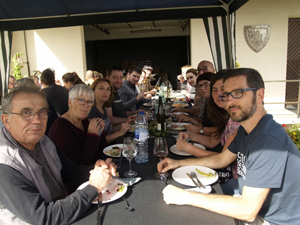
After lunch we descended into the cellar to pick up where we had left off. Stéphane showed us the press that is used for the white wines. The grapes bunches are emptied whole into the press with no need for them to pass through the de-stemming machine. The press contains a large airbag in the middle that inflates and crushes the grapes against the stainless steel, thus releasing the juice. The pressure and time can be controlled depending on the thickness of the skin and the density of the pulp. It is important to not press the grapes too quickly or too hard which can decrease the aromatic qualities of the wine.
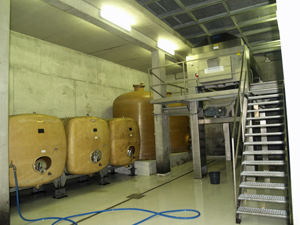
The juice then falls out of the bottom of the press and is pumped into a holding vat. The skin, pips and stalks are then removed from the press and as the winery is organic, it is returned to the vineyard for composting. In the holding vat, the juice is left to rest the time necessary for the small solid particles of skin, pips and stalks that might have slipped through to settle at the bottom of the vat. The clearer juice is then drawn off and put into the vat or cask where it will start the fermentation process.
We also learned that the process is slightly different for red wine. Having passed through the de-stemming machines, the grapes are collected in a vat. The press isn’t used at this stage. After a few days the yeast cells that are naturally present in the grapes will start working on the sugar in the grapes, transforming it into alcohol. As it does so, the temperature will rise, and carbon dioxide will be released. This gas will rise to the top of the vat, and in doing so push the skin and pips to the top. The colour and tannins are held in the skin, so to extract them, the juice needs to be in contact with the skin. To do so, the solid cap is pushed back down into the juice once or twice a day using a plunger. This is known as “pigeage”, and is the same method used in Burgundy for their Pinot Noir grapes.
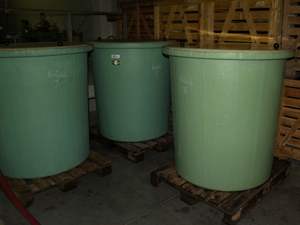
Once the fermentation has finished, no more gas is released and the solid matter then falls to the bottom of the vat. Having done so, the wine is then drawn off and put into barrels to continue the wine-making process. The solid matter is then removed and put into the press to extract the rich, dark coloured wine contained within it. This is known as press wine, and the wine-maker will then decide whether to blend it with the rest of the wine or not.
The day had now reached the end. We’ll pick up from where we left off during the Vinification Experience Days next year and learn about the ageing process and how the wines are prepared for bottling. We look forward to tasting the wines and seeing how they are coming along!
